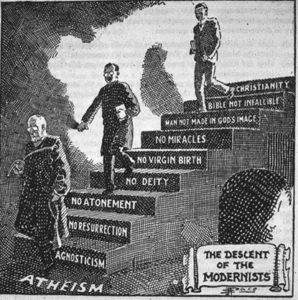Nature, Red in Tooth & Claw, Part 2
In an appendix to their classic book, The Genesis Flood, John Whitcomb and Henry Morris discussed the question of “Paleontology and the Edenic Curse.” They questioned the validity what they referred to as “uniformitarian paleontology,” which dated the formation of fossil layers in hundreds of millions of years, not the thousands of years allotted in their own timeline for creation. This uniformitarianism assumed the death of billions of animals by natural or violent means and the extinction of untold species of animals, like dinosaurs, before the Fall of Adam. “Long ago before the Edenic curse giant flesh-eating monsters like Tyrannosaurus Rex roamed the earth, slashing their victims with ferocious dagger-like teeth and claws.”
But how can such an interpretation of the history of the animal kingdom be reconciled with the early chapters of Genesis? Does the Book of Genesis, honestly studied in the light of the New Testament, allow for the reign of tooth and claw and death and destruction before the Fall of Adam?
In Part 1 of this article we looked at some of the challenges to the modern young earth (YEC) theodicy that Whitcomb and Morris birthed with their book. The organization, Answers in Genesis (AiG) seems to be at the forefront of the current debate over how to interpret Genesis 1-11 from this perspective. For AiG, the age of the earth, the day of creation in Genesis 1 and whether there was animal death before the Fall are all tied together into the same bundle. Writing for AiG in “Did Death of Any Kind Exist Before the Fall?,” Simon Turpin said:
If Genesis is interpreted through the lens of uniformitarian geology then the fossil record documents that millions of years of earth’s history are filled with death, mutations, disease, suffering, bloodshed, and violence. However, if the days of creation in Genesis 1 were only 24 hours long then there is no room for the millions of years of death, struggle, and disease to have taken place before Adam disobeyed God.
Along with others, the work of David Snoke in A Biblical Case for an Old Earth was presented as evidence countering the YEC and AiG claim that their interpretation of Genesis 1-11 is the only biblically valid one. Dr. Snoke said that if you were to acknowledge that the Bible taught animals died before the Fall, many of the other objections to an old earth melted away. Here I’d like to further unpack another of his statements, “The whole point of an old-earth view is to say that things are as they appear, and the earth is full of fossils and fossil matter such as coral and limestone.”
Dr. Snoke noted where YECs like AiG and Whitcomb and Morris identified the Edenic curse in Genesis 3:14-24 as the origination of carnivorous animals. Before the Fall they were said to have been herbivores. Whitcomb and Morris stated that the sharp claws and teeth of the carnivores came from the Fall: “The point is that such specialized structures appeared for the first time after the Edenic curse.” Yet there is no discussion in Scripture of how these modifications (dare we say evolved?) or new species emerged, according to Snoke. “Nowhere does it say that new species of animals [or alterations to existing species] will appear or that the entire order of the physical world will change.”
Snoke suggested that two different interpretive models of the creation, fall and new creation played a role in the debate over whether animal death occurred before the Fall. The models are illustrated below in the following table reproduced from A Biblical Case for an Old Earth.
|
|
View I
|
|
|
World of Genesis 1-2 |
|
World of Revelation 21-22 |
|
|
Our world (digression) |
|
|
|
View II
|
|
|
|
|
World of Revelation 21-22 |
|
World of Genesis 1-2 |
Our world |
|
In the first model, the original created world and the new heavens & earth of Revelation are essentially the same. The lost, perfect Edenic world is restored; and our present world is radically different from either. In support of this perspective, the imagery of the Garden of Eden found in Revelation 22:1-3 is noted: There is the Tree of Life, a river and the declaration that “No longer will there be anything accursed.” Snoke does not further elaborate on this model, but the assumed lack of death, disease, and suffering for animals (what AiG calls natural evil) and humans before the Fall would fit in equating them.
In the section of his article addressing whether there was natural evil before the Fall, AiG’s Terry Mortenson said the declaration by God was that his creation was “very good.” Not only did this indicate that land creatures were vegetarian before the Fall, but how could “millions of years of death and other natural evil be called ‘very good’?” He went on to Isaiah 11:6-9 and 65:25-26, which speak of a future state of creation, where the wolf and the lamb will dwell together; the lion eats straw like the ox; the cow and the bear will graze together and their young will lie down together.
The scene in view is one of complete peace and harmony. For some animals to hunt and kill other animals is described as hurting, destroying, and doing evil. Given this language, is it really possible that carnivores would be destroying other animals (whether healthy or diseased) and earthquakes, tsunamis, hurricanes, and asteroid impacts causing animal death and extinction would be happening for hundreds of millions of years in God’s “very good” creation before Adam sinned?
In the second model, the original created world and our current world are essentially the same. The old earth premise is that things are as they appear. Here, the world to come in Revelation is utterly different. Dr. Snoke illustrated the differences by comparing Revelation 21-22 and Genesis 1-3. Revelation 21 said there will be no more sea, night or sun, while the sea, sun and night are part of the created order in Genesis 1. Also it’s “the first heaven and the first earth” that has passed away in Revelation 21:1.
In other words, the heaven and earth of Genesis 1 (presented in Gen. 1:1) are lumped in together with our present heaven and earth, as a unity that will be destroyed when Christ comes again to make all things new. There is no mention in Scripture of a major physical change of the world at the fall.
The Garden of Eden is a type of heaven in the second model, but not equal to it. Other types in Scripture include the temple in Jerusalem for the true temple of God in heaven (Hebrews 8:1-5). King David was a type of the Messiah. The Garden gives us a picture of heaven as the temple in Jerusalem does of the holiness of God in his heavenly throne room. “The Garden was a space of special protection made for human beings, where God walked with man.”
John Walton seems to have a similar sense to David Snoke of the Garden of Eden in The Lost World of Genesis One. He said scholars have recognized the temple and tabernacle contained a good bit of imagery from the Garden of Eden. They also point out how gardens commonly adjoined sacred space in the ancient world. Strictly speaking then, the Garden of Eden in Walton’s view was not a garden for man, but the garden of God. Walton then quoted biblical scholar Gordon Wenham, who said:
The garden of Eden is not viewed by the author of Genesis simply as a piece of Mesopotamian farmland, but as an archetypal sanctuary, that is a place where God dwells and where man should worship him. Many of the features of the garden may also be found in later sanctuaries particularly the tabernacle or Jerusalem temple. These parallels suggest that the garden itself is understood as a sort of sanctuary.
Outside of this Garden, according to Snoke, was the dangerous natural world. The model fits with God forcefully driving the man from the Garden he had been originally charged to work and keep. Instead of dwelling in the pleasant and peaceful Garden, God banished him into the outer darkness where “nature, red in tooth and claw” was the rule. There the ground was cursed and he would work it by the sweat of his brow and eat of it in pain. He said:
In my view, the powerful forces that existed outside the Garden, which included darkness, the sea, and carnivorous animals, existed prior to the fall as judgments held in readiness, as visible threats to Adam and Eve of the contrast between their protected state of grace and the possible consequences of leaving God’s presence.
There seems to be enough biblical evidence to say animals died before the Fall. As I mentioned in Part 1, there is also credible biblical evidence to allow for the old earth creation acceptance of millions of years for the process. Things in our world today are as they appear. The nature of animal life was not changed from grass eaters to meat eaters by the Edenic curse. Nature, red in tooth in claw existed outside the Garden before the Fall, apparently for millions of years, and became part of human existence when we were banished from the Garden—until Christ comes again to make everything new. Maranatha.
For more articles on creation in the Bible, see the link “Genesis & Creation.”






